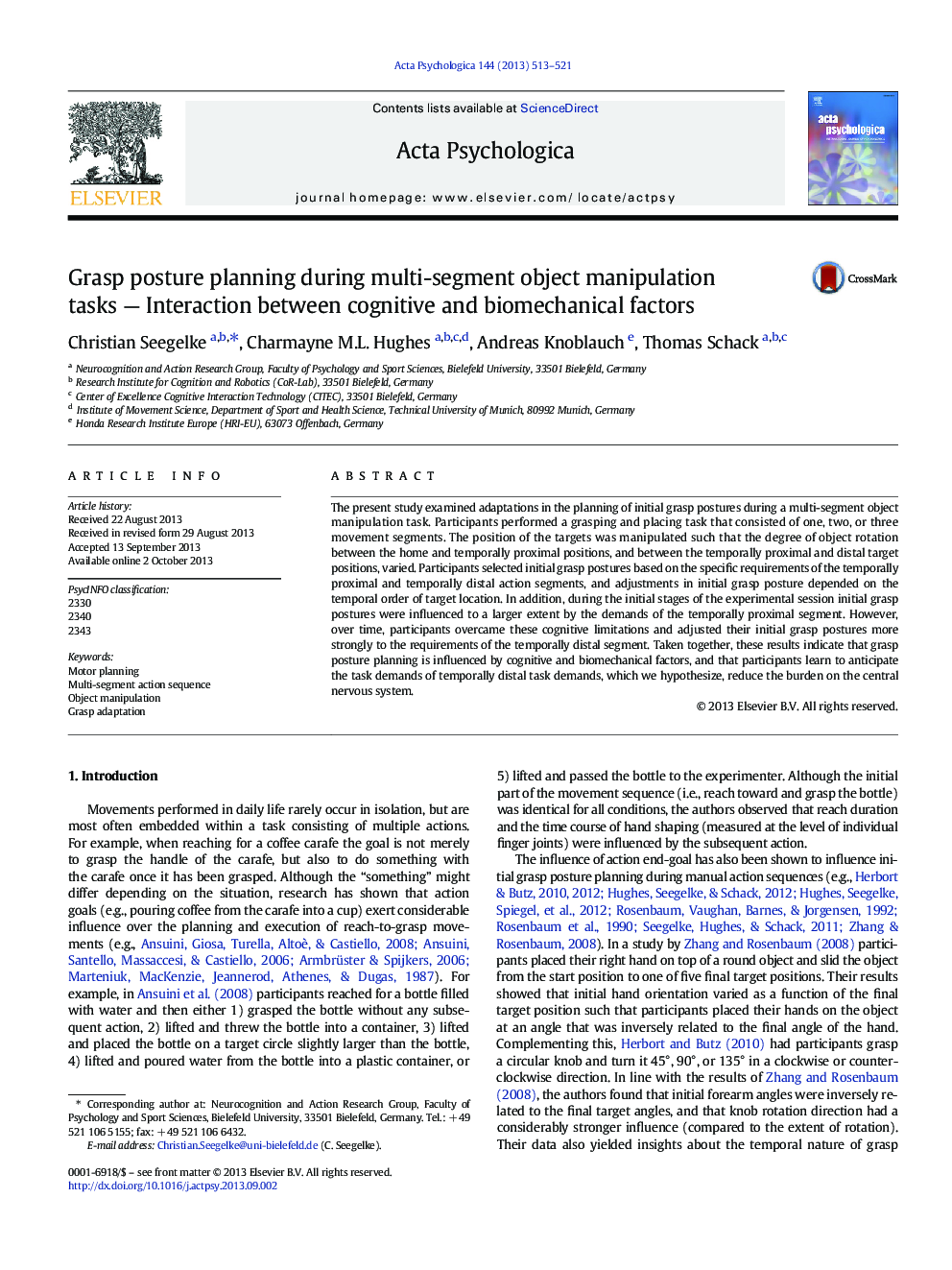| کد مقاله | کد نشریه | سال انتشار | مقاله انگلیسی | نسخه تمام متن |
|---|---|---|---|---|
| 10453802 | 920249 | 2013 | 9 صفحه PDF | دانلود رایگان |
عنوان انگلیسی مقاله ISI
Grasp posture planning during multi-segment object manipulation tasks - Interaction between cognitive and biomechanical factors
ترجمه فارسی عنوان
چگونگی برنامه ریزی وضع در هنگام انجام وظایف دستکاری چندگانه - تعامل بین عوامل شناختی و بیومکانیک
دانلود مقاله + سفارش ترجمه
دانلود مقاله ISI انگلیسی
رایگان برای ایرانیان
کلمات کلیدی
2330، 2340، 2343، برنامه ریزی موتور، دنباله عمل چند مرحله ای، دستکاری شی، سازگاری درک،
ترجمه چکیده
در این تحقیق، سازگاری در برنامه ریزی موقعیت های درک ابتدایی در طی یک کار دستکاری چندگانه مورد بررسی قرار گرفت. شرکت کنندگان انجام یک درک و قرار دادن کار که شامل یک، دو یا سه جنبش جنبش بود. موقعیت اهداف به گونه ای دستخوش تغییر شده است که درجه چرخش ابعاد بین موقعیت های موضعی و موقعیت پروگزیمال و بین موقعیت های موقتی و ممتد هدف، متنوع است. شرکت کنندگان مقادیر اولیه را با توجه به الزامات خاصی از بخش های زمانی موقت و زمان دفاعی انتخاب کردند و تنظیمات در حالت اولیه درک شده بستگی به منظر زمانی مکان مورد نظر داشت. علاوه بر این، در مراحل ابتدایی جلسه تجربی، موقعیت های درک اولیه، به واسطه تقاضای سقف پروگزیمال زمانی تحت تأثیر قرار گرفتند. با این حال، در طول زمان، شرکت کنندگان این محدودیت های شناختی را از بین بردند و موقعیت های اولیه خود را با توجه به الزامات بخش های زمانی ممتد تنظیم کردند. با توجه به این نتایج، این نتایج نشان می دهد که برنامه ریزی استراتژیک درک شده از عوامل شناختی و بیومکانیک تحت تاثیر قرار می گیرد و شرکت کنندگان می آموزند که انتظارات کار را از خواسته های کاری موقت دفاعی پیش بینی کنند، که ما فرض می کنیم، فشار بر سیستم عصبی مرکزی را کاهش می دهد.
موضوعات مرتبط
علوم زیستی و بیوفناوری
علم عصب شناسی
علوم اعصاب شناختی
چکیده انگلیسی
The present study examined adaptations in the planning of initial grasp postures during a multi-segment object manipulation task. Participants performed a grasping and placing task that consisted of one, two, or three movement segments. The position of the targets was manipulated such that the degree of object rotation between the home and temporally proximal positions, and between the temporally proximal and distal target positions, varied. Participants selected initial grasp postures based on the specific requirements of the temporally proximal and temporally distal action segments, and adjustments in initial grasp posture depended on the temporal order of target location. In addition, during the initial stages of the experimental session initial grasp postures were influenced to a larger extent by the demands of the temporally proximal segment. However, over time, participants overcame these cognitive limitations and adjusted their initial grasp postures more strongly to the requirements of the temporally distal segment. Taken together, these results indicate that grasp posture planning is influenced by cognitive and biomechanical factors, and that participants learn to anticipate the task demands of temporally distal task demands, which we hypothesize, reduce the burden on the central nervous system.
ناشر
Database: Elsevier - ScienceDirect (ساینس دایرکت)
Journal: Acta Psychologica - Volume 144, Issue 3, November 2013, Pages 513-521
Journal: Acta Psychologica - Volume 144, Issue 3, November 2013, Pages 513-521
نویسندگان
Christian Seegelke, Charmayne M.L. Hughes, Andreas Knoblauch, Thomas Schack,
